Alaska Fish & Wildlife News
October 2023
Feeding Birds in Fall and Winter in Alaska
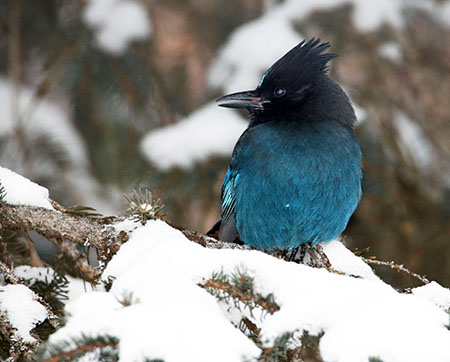
Feeding birds is one of the joys of fall and winter for us. The summer songbirds are gone but our year-round neighbors are sociable, and the bustling flocks of chickadees and juncos are reliable and welcome visitors. Surprise guests keep things interesting, and we’ve known sparrows to provide mid-winter songs.
Feeding birds can be as simple as scattering seeds on the ground, or a more sophisticated operation drawing a variety of species. But there are a few important details to keep in mind.
Bears
We don’t feed birds in spring and summer – a bird feeder is a magnet for hungry bears and there’s wild food growing everywhere for birds. In Southeast Alaska, as in South-central, we don’t start feeding until after Halloween.
“November first is the official safe date,” said wildlife biologist Katie Christie, a bird researcher for the Alaska Department of Fish and Game. “We have so many bears here in Anchorage - black bears and brown bears. We know from monitoring collared bears that black bears are generally down by early October, but brown bears can stay active until Thanksgiving. Of course, it varies, and this year we’re having some nice warm days so the black bears may den later, but typically they den quite a bit earlier than brown bears.”
Who and what to feed
Katie Christie has multiple feeders on her deck in Anchorage. “To attract a diversity of birds you need a diversity of foods and delivery methods,” she said.
She has four different feeders - and water, a welcome winter treat. A heated bowl provides liquid water for birds throughout the cold months. They don’t bathe in winter, it’s strictly for drinking.
“They use it a lot, all of the birds but especially nuthatches,” she said. “They don’t need to burn calories eating snow, they can drink the water.”
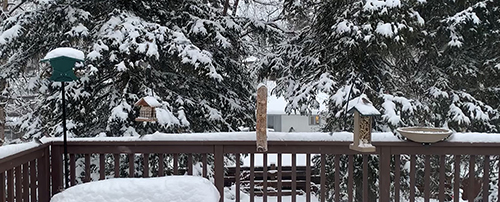
One feeder offers raw peanuts in the shell, a favorite of Steller’s jays. They eat them “fresh,” and they cache them for future dining. Christie said not only has she found them cached in her garden, they’ve also been forgotten by the birds and later sprouted into peanut plants.
Another feeder offers shelled, unsalted peanuts. “Nuthatches like peanuts, and chickadees also feed on them,” she said. “Steller’s jays will eat them whole, but not chickadees. They’ll break up a peanut into little bite-sized bits with their bill.”
The third feeder provides suet and is a favorite for downy and hairy woodpeckers. It’s section of a birch tree trunk about five inches in diameter and three feet long, hung vertically. Holes about an inch across are drilled into it and loaded with plugs of suet.
“It’s a great feeder for woodpeckers,” Christie said. “They like it better than a cage suet feeder – those are fine for chickadees and nuthatches, but not woodpeckers. Woodpeckers like to rest their tails against the log as they feed. They have specialized tail feathers for support, not like other birds’ tail feathers that are just for flight. Woodpeckers have buttressing feathers that support them when they are hammering against a tree - really helps them get more force into their hammering with their bills.”
A fourth, covered feeder provides black sunflower seeds. It’s popular with black-capped and boral chickadees, redpolls, pine siskins, and Steller’s jays early in the winter. It’s also squirrel-proof.
Placement
Christie noted that birds prefer feeders that have adjacent cover. “They want to grab the seed and eat it somewhere else, otherwise they are exposed in the open. It’s helpful to have trees or bushes, some vegetation they can fly to quickly for cover.”
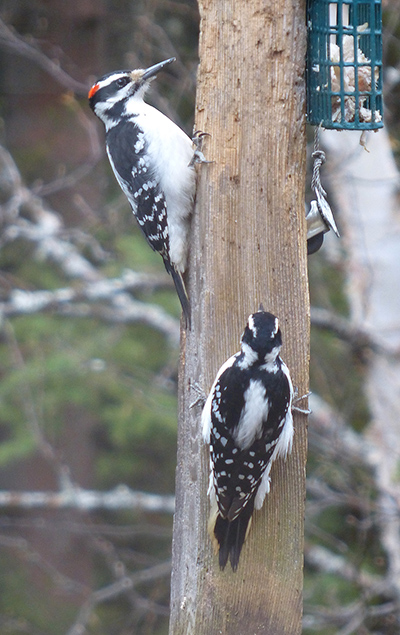
Gwen Baluss has worked with birds for much of her life, she’s a bird bander and past president of the Juneau Audubon Society. She encourages people who feed birds to think about the big picture: Am I creating a good place for birds to come into? Are there hazards, like drawing a bird close to a window it could fly into? Are they getting close to cats?
She suggests that feeders either be right next to a window or more than 40 feet away. If something spooks a group of feeding birds, a startled bird has space to navigate around the window, or will not have developed enough speed to be hurt if it does hit. Making those adjacent windows more visible to birds is a good idea too.
For those of us in rainy Southeast Alaska, keeping the feeder dry is a big issue. It’s important to keep feeders clean, as wet feeders mean spoiled and moldy seeds. Most feeders are not waterproof and leak.
“It’s really hard to keep them dry here in Juneau with our rain,” Baluss said. “You can get a small one and change out the seeds regularly, or have it under an awning.”
Bird feeders can spread diseases and should be cleaned every year – or more. Scrub off crusted seeds, rinse in a mild bleach water solution, and dry out the feeder before hanging it back up. Spoiled seeds can sicken birds, and viral diseases can vector where birds congregate.
“We haven’t had a lot of disease outbreaks here, but it is something to think about. It’s important to keep the feeder clean,” Baluss said. “Years ago, there was a salmonella outbreak on Douglas Island that affected crossbills and pine siskins. It was pretty bad.”
Christie said avian keratin disorder is causing deformed bills in chickadees and corvids such as ravens. Most likely a virus, the disorder causes their bills to grow long and criss-crossed and the deformity interferes with the birds’ ability to forage and preen. “If you see birds with deformed bills at your feeder, take it down, clean it, and wait a few weeks to put up again. Feeders can spread other diseases, and if you ever see birds that appear to be sick at your feeder, take it down.”
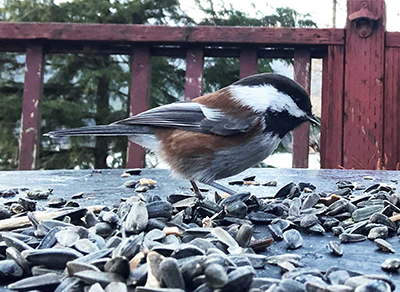
You can report the deformity via a USGS beak deformity observation report (please get a photo if possible).
Cleaning includes the area below the feeder. Rake or shovel up bird droppings, seeds and seed hulls. This also helps prevent scattered food from attracting rodents (and bears, come spring). On snow-covered lawns, scraping off a few layers of snow should do the trick.
And regarding Alaska’s ubiquitous red squirrels. Some are serious nest predators, eating eggs, nestlings and even adult birds. Baluss said it depends on the squirrel - some individual red squirrels are good at nest searching and have a taste for eggs. Others don’t. Either way, squirrels are very good at scattering seeds and making a big mess of your feeder. And Baluss notes that all of them can eat a lot of expensive birdseed in a short time.
No feeder feeding
“I generally don’t use feeders,” Baluss said. “I find a good place, like a nice patch of ground under a tree, and just sprinkle some seeds, no more than the birds are going to go through that day. It’s easy, and there’s nothing to clean. But not everyone’s yard has a good space on the ground. In Sitka there are rats, they can’t feed on the ground.”
She said a big conifer in her yard provides a mostly snow-free patch in winter. “Sometimes I sprinkle some seeds on a flat board, like a fence board.”
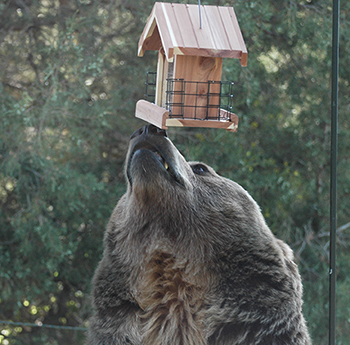
This method of feeding became very popular with my daughters after a lone pigeon showed up at our feeder. He was a scout (of course) and scattering just a meals-worth of food led to some interesting developments. Haley loved that pigeons would allow her to get very close, and she soon had them eating out of her hand. She has a keen eye for subtle differences in plumage and toe-nail colors, and within a few weeks she many of them named and trained to land on her. I understand why many people are derisive of “sky-rats,” but I have a new appreciation for pigeons thanks to feeding.
Baluss highlighted another method of no-feeder-feeding that works year-round.
“It’s good to think about other ways to feed birds in your yard - planting native plants like willows, alders, and those thick cedars that shelter birds.”
Cedars, including arborvitae (not locally native but a popular cold-tolerant landscaping favorite) provide good cover and shelter. We consistently had varied thrush, hermit thrush and robins nest in ours, and one year there were two nests in the same tree next to our porch.
Trees that bear fruit and berries and popular with robins and waxwings. Sitka mountain ash (also known as western mountain ash) is a native tree that does well, and the birds also help propagate the trees by spreading the seeds. Alaskans tend to be most familiar with the taller and much more widespread European mountain ash; the native tree is more shrub-like with larger leaves and would be the choice to deliberately plant.
Baluss notes there are benefits to an untended yard. Letting shrubs grow wild and unkempt, and piles of sticks, snags, branches and logs are good for birds (and a great excuse not to clean up the yard)
Bird sound system
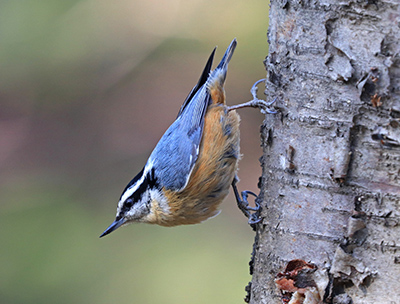
Mike Taras is a biologist and wildlife education specialist in Fairbanks. He feeds birds black sunflowers seeds and suet, and provides scraps of moose fat. He gets boreal and black-capped chickadees, red breasted nuthatches; grosbeaks feed on the ground on seeds that fall, and grey jays, downy and hairy woodpeckers come into the suet. A speaker conveys the outdoor bird chatter into his cabin.
“I have an outdoor microphone, so when I’m inside I can hear what’s going on,” he said.
It’s really sensitive, he said, and although he lives in town (near Creamer’s Field) he’s isolated enough that cars and traffic noise are not audible. Thanks to the sound system, he learned that nuthatches make a quiet, squeaky low sound when they feed, in addition to their regular nasally call.
“I would’ve never known that if I hadn’t had the sound system,” he said. “That’s also how I found out about the owl. Two years ago I’m listening and I heard a lot of chaos with the birds. I went outside and followed the noise and there was a boreal owl sitting about 10 feet up in the spruce trees. It didn’t make any noise, the bird alarms made me go look for it. They were pretty emphatic.”
Extras on feeding
Native Alaska and Exotic Plants Used by Wildlife
Cats & Birds: Protect birds & keep cats safe
Subscribe to be notified about new issues
Receive a monthly notice about new issues and articles.
